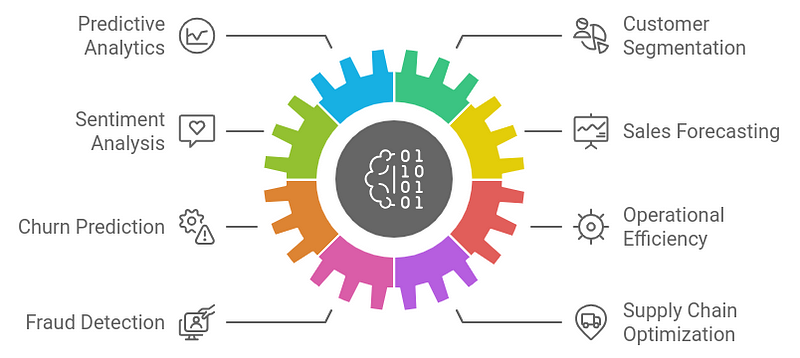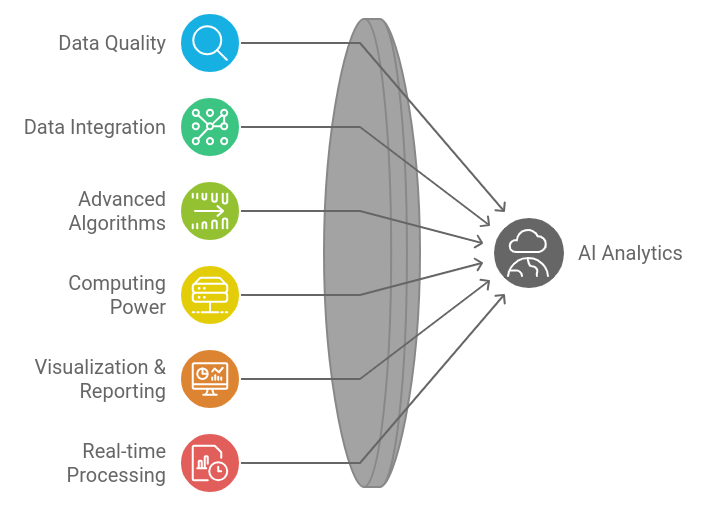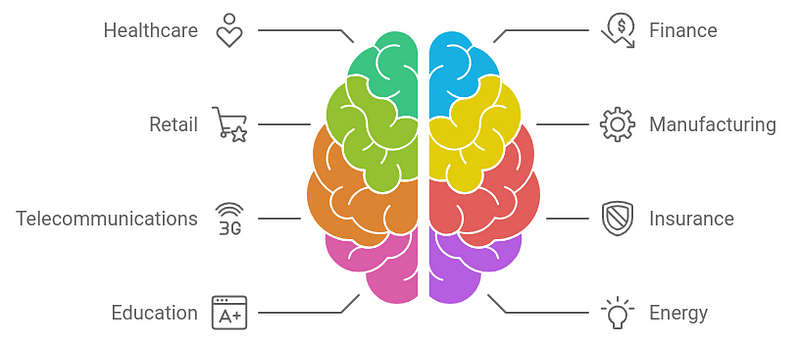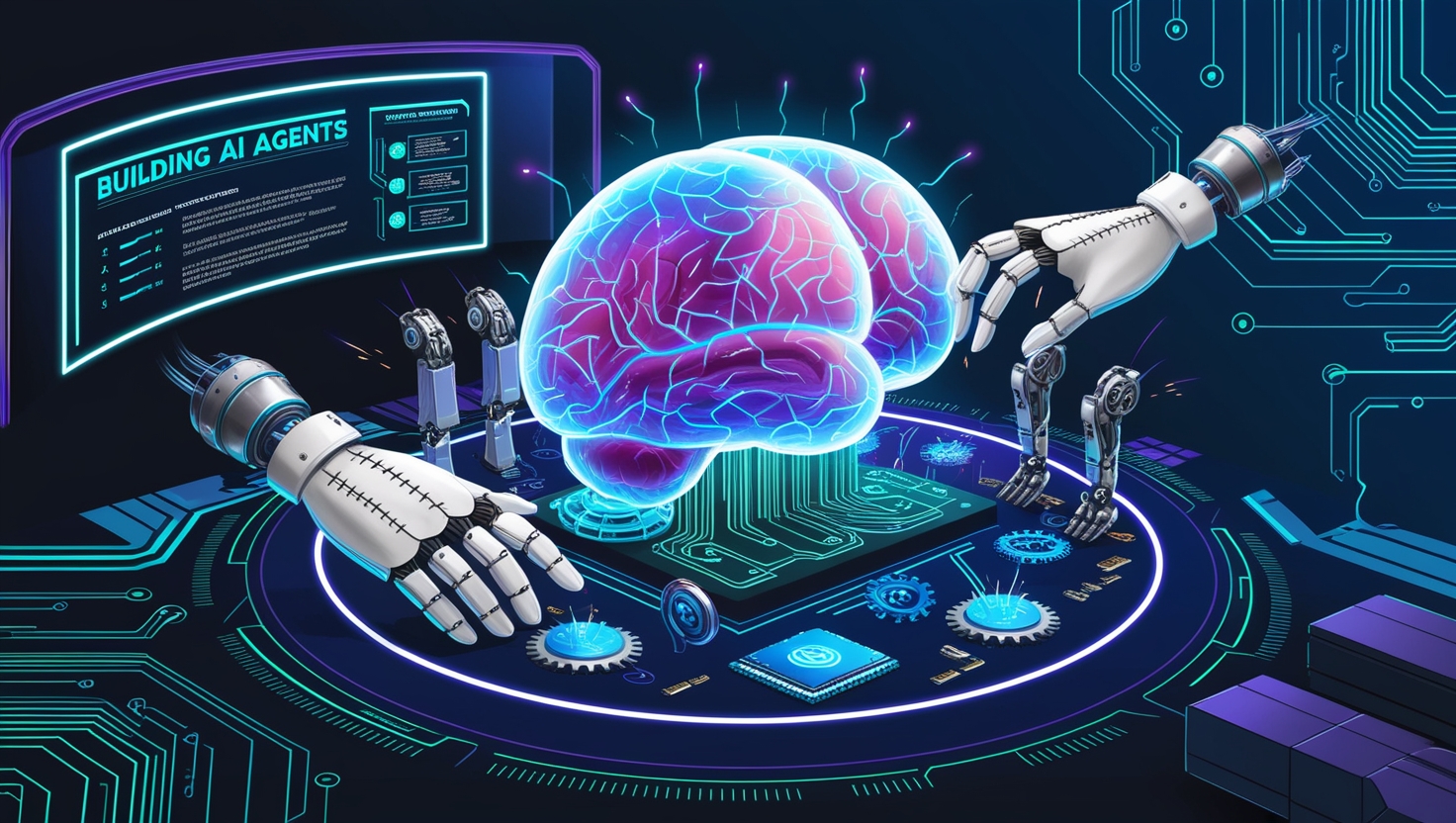In today’s fast-paced business landscape, leveraging data effectively has become crucial for sustained success and strategic growth. AI in analytics is revolutionizing how organizations interpret and utilize vast amounts of data, providing unparalleled insights that drive informed decision-making. By harnessing advanced algorithms and machine learning techniques, businesses can analyze trends, predict customer behavior, and identify operational efficiencies that were previously hidden in complex datasets.

This not only enhances the accuracy of forecasts but also empowers organizations to tailor their strategies to meet evolving market demands. Furthermore, AI analytics tools automate time-consuming processes, allowing teams to focus on high-value tasks and innovate more rapidly. As companies increasingly adopt AI in analytics, they position themselves to gain a competitive edge, adapt to changes in real time, and optimize resource allocation.
Embracing this technological advancement is not just about staying relevant; it’s about paving the way for long-term growth and profitability in an ever-evolving business environment. Ultimately, AI in analytics is the key to unlocking new opportunities and driving strategic initiatives that propel organizations toward success.
What is AI in Analytics?
AI in analytics refers to the application of artificial intelligence technologies and algorithms to analyze and interpret data, transforming raw information into actionable insights. By utilizing machine learning, natural language processing, and advanced statistical methods, AI analytics enables organizations to uncover patterns, trends, and correlations within large datasets that may not be immediately apparent through traditional analytical methods. This process enhances the accuracy and speed of data analysis, allowing businesses to make more informed decisions based on real-time insights.
AI in analytics empowers predictive modeling, enabling organizations to forecast future trends and customer behaviors, which is invaluable for strategic planning and resource allocation. Additionally, it automates repetitive data processing tasks, freeing up valuable time for data analysts and decision-makers to focus on more strategic initiatives. As a result, businesses can adapt quickly to market changes, optimize operations, and personalize customer experiences. Ultimately, AI in analytics is a transformative force that enhances decision-making capabilities, fosters innovation, and drives competitive advantage in an increasingly data-driven world.
Benefits of AI in Analytics
The benefits of AI in analytics are numerous and can significantly enhance data processing, decision-making, and operational efficiency. Here are some key advantages:

- Enhanced Data Processing: AI can analyze large volumes of data quickly and accurately, enabling real-time insights and faster decision-making.
- Predictive Analytics: AI algorithms can identify patterns and trends in historical data, allowing organizations to predict future outcomes and make proactive decisions.
- Automated Insights: AI can automate the generation of reports and insights, reducing the need for manual analysis and freeing up time for analysts to focus on strategic tasks.
- Improved Accuracy: AI reduces human error in data analysis, leading to more reliable insights and better-informed business decisions.
- Natural Language Processing (NLP): AI-powered tools can interpret and analyze unstructured data, such as customer feedback or social media posts, providing deeper insights into customer sentiments and preferences.
- Personalization: AI enables businesses to analyze customer data to create personalized experiences, improving customer satisfaction and loyalty.
- Cost Efficiency: By automating repetitive tasks and improving accuracy, AI can lead to significant cost savings in data analysis and reporting processes.
- Scalability: AI solutions can easily scale with the growth of data, allowing organizations to handle increasing amounts of information without a proportional increase in resources.
- Anomaly Detection: AI can quickly identify anomalies or outliers in data sets, which can help organizations detect fraud, operational inefficiencies, or potential risks.
- Data Visualization: AI can enhance data visualization tools, making it easier for users to interpret complex data sets and derive actionable insights.
- Integration with Other Technologies: AI analytics tools can seamlessly integrate with other technologies, such as IoT and cloud computing, enabling comprehensive data analysis across multiple platforms.
- Enhanced Decision-Making: With AI analytics providing deeper insights and predictive capabilities, organizations can make more informed and timely decisions, leading to better overall performance.
These benefits make AI an essential tool for organizations looking to leverage data analytics for strategic advantage.
Key Applications of AI in Business Analytics
AI has numerous applications in business analytics that help organizations optimize operations, improve decision-making, and enhance customer experiences. Here are some key applications:

☛ Predictive Analytics: AI algorithms analyze historical data to forecast future trends, helping businesses anticipate market changes, customer behavior, and demand patterns.
☛ Customer Segmentation: AI enables companies to segment their customer base more effectively by analyzing purchasing behavior, preferences, and demographics, allowing for targeted marketing strategies.
☛Sentiment Analysis: Utilizing Natural Language Processing (NLP), AI can analyze customer feedback from various sources (like social media and reviews) to gauge public sentiment and make informed marketing decisions.
☛ Sales Forecasting: AI models analyze sales data and external factors to predict future sales performance, assisting businesses in inventory management and resource allocation.
☛ Churn Prediction: AI can identify at-risk customers by analyzing usage patterns and engagement levels, allowing businesses to implement retention strategies proactively.
☛ Operational Efficiency: AI analyzes operational data to identify inefficiencies and optimize processes, improving overall productivity and cost-effectiveness.
☛ Fraud Detection: Machine learning algorithms monitor transactions in real-time to detect unusual patterns, helping businesses identify and mitigate potential fraud risks.
☛ Supply Chain Optimization: AI analyzes supply chain data to forecast demand, optimize inventory levels, and enhance logistics efficiency.
☛ Personalization: AI enables businesses to create personalized experiences for customers by analyzing data to recommend products and services tailored to individual preferences.
☛ Business Intelligence (BI): AI enhances BI tools by automating data collection and analysis, providing actionable insights through dashboards and visualizations.
☛ Risk Management: AI assesses risk by analyzing market conditions and historical data, enabling businesses to make informed decisions and mitigate potential losses.
☛ Workforce Analytics: AI analyzes employee performance and engagement data to inform HR strategies, improve employee retention, and enhance organizational culture.
☛ Chatbots and Virtual Assistants: AI-driven chatbots provide customer support and handle inquiries, freeing up human resources and improving response times.
☛ Financial Analysis: AI automates financial reporting and forecasting, enhancing accuracy and providing insights into financial performance.
☛Real-time Analytics: AI enables businesses to process and analyze data in real-time, providing immediate insights that can influence strategic decisions.
These applications illustrate how AI is transforming business analytics, enabling organizations to leverage data for competitive advantage and operational excellence.
Why is AI Analytics important?
AI analytics is crucial for several reasons, significantly impacting how organizations operate and make decisions. Here are some key points highlighting its importance:

- Data-Driven Decision-Making: AI analytics enables organizations to make informed decisions based on comprehensive data analysis, reducing reliance on intuition and guesswork.
- Speed and Efficiency: AI can process and analyze large volumes of data much faster than traditional methods, allowing businesses to gain insights in real-time and respond quickly to market changes.
- Enhanced Accuracy: By minimizing human error in data analysis, AI ensures that insights derived from analytics are more reliable and accurate, leading to better decision outcomes.
- Predictive Insights: AI analytics utilizes historical data to identify patterns and trends, allowing businesses to forecast future events and outcomes, which is essential for strategic planning.
- Cost Savings: Automating data analysis through AI reduces labor costs associated with manual analysis and enables organizations to allocate resources more effectively.
- Improved Customer Experience: AI analytics helps businesses understand customer behavior and preferences, leading to more personalized marketing strategies and enhanced customer satisfaction.
- Scalability: AI systems can easily scale to handle increasing data volumes as businesses grow, ensuring that analytics capabilities remain robust and effective.
- Proactive Risk Management: AI analytics can identify potential risks and anomalies in data, enabling organizations to take preventive measures before issues escalate.
- Competitive Advantage: Leveraging AI analytics allows organizations to stay ahead of competitors by making faster, more informed decisions and responding to market dynamics more effectively.
- Resource Optimization: AI helps businesses optimize their operations by identifying inefficiencies and areas for improvement, leading to better resource management.
- Integration of Unstructured Data: AI can analyze unstructured data (e.g., social media posts, customer reviews) alongside structured data, providing a more comprehensive view of business performance and customer sentiment.
- Enhanced Collaboration: AI analytics tools facilitate collaboration across departments by providing unified access to insights, fostering a data-driven culture within the organization.
AI analytics is important because it empowers organizations to leverage data for strategic advantage, improve operational efficiency, enhance customer experiences, and drive innovation, ultimately leading to sustainable growth and success.
Pillars of AI Analytics
The pillars of AI analytics are foundational elements that support effective data analysis and drive the implementation of AI technologies within organizations. Here are the key pillars:

➤ Data Quality: High-quality, accurate, and reliable data is essential for effective AI analytics. This pillar focuses on data collection, cleaning, and validation processes to ensure that the analytics produce meaningful insights.
➤ Data Integration: AI analytics requires the integration of data from various sources (structured and unstructured) to provide a comprehensive view. This pillar emphasizes the importance of data interoperability and seamless data flow across systems.
➤ Advanced Algorithms: The core of AI analytics lies in the algorithms used for analysis. This pillar includes machine learning models, statistical techniques, and other advanced analytical methods that enable predictive and prescriptive analytics.
➤ Computing Power: Robust computing resources, including cloud computing and high-performance computing, are necessary to handle large datasets and complex algorithms. This pillar ensures that organizations have the necessary infrastructure to support AI analytics.
➤ Visualization and Reporting: Effective data visualization tools are crucial for interpreting and presenting analytics insights. This pillar focuses on creating intuitive dashboards and reports that facilitate understanding and informed decision-making.
➤ Real-time Processing: The ability to analyze data in real time is a key pillar of AI analytics. This allows organizations to respond promptly to changes and opportunities in the market, enhancing agility and responsiveness.
➤ User-Friendly Interfaces: For AI analytics to be widely adopted, it must be accessible to non-technical users. This pillar emphasizes the development of user-friendly interfaces that enable business users to interact with analytics tools easily.
➤ Scalability: AI analytics solutions should be scalable to accommodate growing data volumes and evolving business needs. This pillar ensures that the analytics framework can adapt to changes in the organization.
➤ Ethics and Governance: As AI analytics involves sensitive data and decision-making processes, establishing ethical guidelines and governance frameworks is crucial. This pillar focuses on ensuring transparency, accountability, and compliance with data regulations.
➤ Collaboration and Culture: Fostering a data-driven culture within the organization encourages collaboration between departments and teams. This pillar emphasizes the importance of cross-functional collaboration in leveraging AI analytics for strategic advantage.
By focusing on these pillars, organizations can effectively harness the power of AI analytics, driving better insights, enhanced decision-making, and improved business outcomes.
AI Analytics Use Cases by Industry
AI analytics has diverse applications across various industries, each leveraging data to enhance efficiency, improve decision-making, and drive innovation. Here are some notable use cases by industry:

1. Healthcare
- Predictive Healthcare: AI analytics predicts patient outcomes, enabling proactive interventions for chronic diseases.
- Medical Imaging: AI algorithms analyze medical images (like X-rays and MRIs) to assist in diagnosing conditions.
- Operational Efficiency: Optimizing hospital operations, including staffing and resource allocation, to enhance patient care and reduce wait times.
2. Finance
- Fraud Detection: AI systems analyze transaction patterns in real time to identify and prevent fraudulent activities.
- Risk Assessment: Predictive analytics assesses credit risk and enables better lending decisions.
- Algorithmic Trading: AI-driven models analyze market data to execute trades automatically based on predictive insights.
3. Retail
- Customer Segmentation: AI analyzes purchasing behavior to segment customers for targeted marketing campaigns.
- Inventory Management: Predictive analytics optimizes stock levels by forecasting demand based on historical data and trends.
- Personalized Shopping Experiences: Recommender systems utilize AI to provide personalized product suggestions to customers.
4. Manufacturing
- Predictive Maintenance: AI analytics forecasts equipment failures by analyzing machine performance data, minimizing downtime.
- Quality Control: Automated inspection systems use AI to identify defects in products during the manufacturing process.
- Supply Chain Optimization: AI analyzes supply chain data to enhance logistics, reduce costs, and improve delivery times.
5. Telecommunications
- Churn Prediction: AI identifies at-risk customers by analyzing usage patterns, enabling targeted retention strategies.
- Network Optimization: AI analytics optimizes network performance by analyzing traffic patterns and user demand.
- Customer Support Automation: AI-driven chatbots provide immediate assistance to customers, improving service efficiency.
6. Insurance
- Claims Processing: AI automates claims assessment by analyzing documentation and historical claims data for faster processing.
- Risk Management: Predictive models assess risk factors to determine policy pricing and underwriting decisions.
- Fraud Detection: AI identifies suspicious claims patterns, helping insurers minimize losses.
7. Education
- Personalized Learning: AI analytics tailors educational content to individual student needs, improving engagement and outcomes.
- Student Retention: Predictive analytics identifies students at risk of dropping out, allowing for timely interventions.
- Administrative Efficiency: AI streamlines administrative tasks, such as enrollment and scheduling, enhancing operational efficiency.
8. Energy
- Predictive Analytics for Maintenance: AI forecasts equipment failures in power plants, allowing for timely maintenance.
- Demand Forecasting: AI analyzes consumption patterns to predict energy demand and optimize supply.
- Grid Management: AI analytics improves grid efficiency by analyzing real-time data from multiple sources.
9. Transportation and Logistics
- Route Optimization: AI algorithms analyze traffic patterns to determine the most efficient routes for delivery vehicles.
- Demand Prediction: Predictive analytics forecasts demand for rideshare services, optimizing driver allocation.
- Fleet Management: AI enhances fleet performance by monitoring vehicle health and optimizing maintenance schedules.
10. Marketing and Advertising
- Campaign Optimization: AI analyzes campaign performance data to optimize ad placements and budgets in real time.
- Customer Insights: AI extracts actionable insights from customer data, guiding product development and marketing strategies.
- Sentiment Analysis: AI analyzes customer feedback and social media posts to gauge brand sentiment and inform marketing strategies.
These use cases illustrate how AI analytics is transforming industries by providing valuable insights, enhancing operational efficiency, and driving innovation.
Challenges and Considerations
While AI in analytics offers significant advantages, it also presents several challenges and considerations that organizations must navigate. One major concern is data quality; inaccurate or incomplete data can lead to misleading insights, undermining decision-making processes. Additionally, the complexity of AI algorithms can make it difficult for non-experts to interpret results, potentially creating a knowledge gap within the organization. Another challenge is the ethical implications of data usage, including privacy concerns and the risk of bias in AI models, which can perpetuate existing inequalities if not carefully managed.
Organizations must also consider the integration of AI analytics with existing systems and workflows, as compatibility issues can hinder implementation. Furthermore, ensuring that teams are adequately trained to leverage AI tools is essential for maximizing their potential. Lastly, companies should anticipate the need for ongoing maintenance and updates to AI models to keep pace with evolving data landscapes and business objectives. Addressing these challenges is crucial for successfully harnessing the power of AI in analytics.
Future Trends in AI Analytics
The future of AI in analytics is poised for transformative advancements that will redefine how organizations harness data for strategic growth. One key trend is the rise of augmented analytics, where AI-driven tools will enhance data preparation, insight generation, and analysis, enabling users to make informed decisions with minimal technical expertise. Furthermore, the integration of natural language processing (NLP) will facilitate more intuitive data interactions, allowing users to query data using everyday language.
As organizations increasingly adopt real-time analytics, the demand for AI solutions that can process streaming data and provide immediate insights will grow significantly. Another emerging trend is the focus on explainable AI, which seeks to make AI models more transparent and understandable, addressing ethical concerns surrounding bias and decision-making processes.
Additionally, the convergence of AI with edge computing will enable faster data processing closer to the source, enhancing operational efficiency. These trends indicate a future where AI analytics becomes more accessible, ethical, and capable of driving actionable insights at unprecedented speeds.
Conclusion
In conclusion, the integration of AI in analytics represents a pivotal shift in how businesses approach data-driven decision-making, paving the way for unprecedented success and strategic growth. By harnessing the power of AI, organizations can unlock deeper insights from their data, enabling them to respond more swiftly to market changes and customer needs. The ability to analyze vast datasets in real-time not only enhances operational efficiency but also fosters innovation by identifying new opportunities and optimizing existing processes.
As companies increasingly rely on AI-driven analytics, they cultivate a culture of data literacy and agility, empowering teams to make informed decisions that align with broader business goals. This proactive approach not only mitigates risks but also positions organizations at the forefront of their industries. As we look to the future, embracing AI in analytics will be essential for businesses aiming to navigate the complexities of the modern marketplace. Those who invest in these technologies today will reap significant rewards tomorrow, securing their place as leaders in their respective fields while driving sustainable growth and profitability.
Also Read
- ► What to Consider When Leasing an Electric Forklift for Your Business
- ► Event Video Production Services Tailored for Singaporean Companies
- ► What are the four important tips for selecting the best Social Work Assignment Help to complete their assignments?
- ► How can Shopify Flow be used to Improve Your business?
- ► Top 5 Universities in Australia for MBA Programs
- ► Top Challenges Faced by Saffron Importers and How to Overcome Them
- ► How Can You Ease Find the Right Umrah Packages from Toronto
- ► Discover How Dental Instrument Suppliers Sialkot are Shaping the Future of Dentistry?
- ► Surgical Instrument Manufacturers in Pakistan are Facing Increasing Demand
- ► Great Tips To Stay Positive During The SSC Exam
- ► Why Outdoor Digital Displays in Lewisville TX are Essential for Event Promotion?
- ► Quality Check to Buy T-Shirts for Men and Women Online in 2025
- ► Increase Foot Traffic with Eye Catching Outdoor Signs for Business in Argyle Texas
- ► Choosing Reliable Miller Laryngoscope Blades USA
- ► Why Is It Important to Contact an Accounting Advisory Firms?




